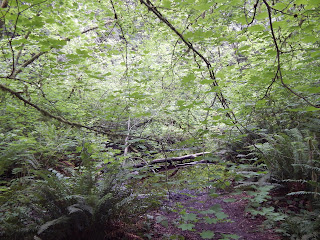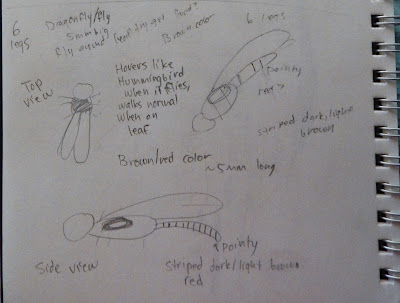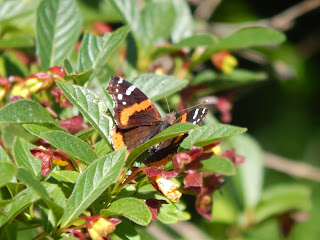Place: McCollum Pioneer Park
Date: 6/3/16 Time: 11:05-12:25
Weather: Sunny
Temp: 60s F
I'm sorry in advance for the lack of photos in this blog. I was using an old camera and most of the pictures came out blurry. Also, you'll notice how I describe things as "turning greener and fuller" a lot throughout this journal. The reason is because I'm at a loss of words for how to describe what I'm seeing. Being "fuller and greener" are the only words that can capture part of my awe at what's changing on my site.
-------------------
Looking at the background, it changed from skinny twigs to hairy twigs. The middle layer of the picture is a vibrant green color full of leaves that end up covering the trees in the background. I can't see the small Douglas fir in the background as easily as I could in the beginning of the quarter. The western redcedar seemed to have also grown leaves during the quarter, contributing to the covering of trees in the background. I just think it's amazing how the red alders and D. firs that I could see so clearly in the beginning of the quarter in the background are hidden by the shrubs and that grew leaves in the forefront of the picture.
 |
| Week 2 Photo |
 |
| Week 9-10 photo |
-----------
You can see the vine maple changed! It grew leaves! The ground is less littered compared to the beginning, and is full of understory little plants. It's not cluttered looking because all the bare twigs are gone! 0.0
 |
| Week 2 photo |
 |
| Week 10 photo |
-------------
You can see the main difference between the two photos is the colors present. Week 2 had a mix of brown and green. There are naked maples and beaked hazelnut in the background. There are lots of twiggy skinny tree/shrubs around. The ground looks super messy and is filled with a lot of duff from decomposed plants.
By Week 10, The site looks much cleaner and greener. The duff and debris seem to have disappeared, or are covered by the sword fern. The vine maple and beaked hazelnut grew leaves and are no longer naked little twigs. Look at Week 2 and you can see all the tree trunks in the background, specifically to the left of the snag. When you look back at Week 10, the trees to the left of the snag disappeared! It's still there, but the leaves from the trees up front is covering the trees in the back. What a change in phenology! I never would have even noticed this if it hadn't been for these pictures.
 |
| Week 2 Photo |
 |
| Week 10 Photo |
-----------------
Week one this spot was very open. There was moss on the Vine maple and a small tree growing on the D. fir trunk. The sword fern is small and slightly brown. The trees and shrubs in the background are bare. Then on Week 10 you can see how the leaves of the Vine maple have grown, the trees in the background and the shrubs seem fuller and greener. This area isn't as opened.
 |
| Week 1 |
 |
| Week 8 |
--------------
Phenology Update:What's changed this week? Well this week there wasn't much difference from last week from what I could see. There were more blooming salmonberries on bushes, although they were orange, small and unripened. The ripened ones are still not there. Thimbleberries are similar, in that only the unripened ones were present. I've noticed there were more creeping buttercups blooming in this area that has actual buttercups blooming.
 |
| Pacific ninebark caught my eye because of the flowers! |
 |
| Bitter fruit of the Indian plum |
 |
| Himalayan Blackberry flowers are starting to bloom! The buds are opening up. |
A super neat thing I saw was two bumblebees mating. At first when I saw the bee flying around, I thought to myself "wow, that is one long bumblebee". But my friend who was with me pointed out that it was not long--that it was two bees that were mating. It was odd because they were flying around and doing normal bee stuff, like flying from bush to bush. Except one bee was on the back or behind of the other. They were stuck together for the entire time I saw them. This week is the most I've seen bees active! Within the 1 hour I was there, I counted 7 bees (5 bumblebees and 2 honeybees).
Change in Plants;
I remember Week 1-2 being very lackluster. There were no flowers, no berries, and no leaves. Even though it was a time transitioning into spring, everything looked like winter. The coniferous evergreen trees were alive and well, but the plants had very small leaves. The sword ferns in the beginning weeks were mostly, brown, dry, and appeared to be dead. But in this final week, the ferns are rich, full, and vibrantly dark green. The berries are abundant (when not eaten by wildlife), the shrubs are tall and filled with lush green leaf. Broadleaf trees have also grown their leaves! Looking at the repeat photo for the Vine Maple, you can see how week 1 was desolate and very open, but week 10 brought about a large shade area because of the leaves. Assessing the Week 1 and Week 10 photos, I can see how there are less brown plants leaves now.
Change in Wildlife:
In the first weeks of this site, I didn't see squirrels at all. None--nada--zippity no. I always thought it was strange, since squirrels are everywhere at all times. However, Week 10 (this week) is the week I finally found them! I actually saw 3! They were climbing up the trees. One even flew!!!!! (Well it jumped, but it freaked me out. It jumped like 3 feet in front of it!)
As for inverts, Week 1 had very little things flying around. I do remember a couple of bees flying around, and of course mosquitoes, and spiders, but that was it. There wasn't any visible variety of inverts. As the weeks went on, slowly around week 3 or 7 (not the weeks during field trip) the spider population increased 0.0 webs everywhere! I was getting bitten non-stop and running into spider webs, swatting at flying things, etc. In this final week, I found a giant red mosquitoe crane looking thing. Unfortunately I forgot to bring my journal and couldn't take a pic, but it looked like a red crane. There are more beetles and flies out. I'm starting to see a couple more slugs too.
Birds are the most noticeable change in behavior, but not quantity. In the beginning of the weeks, I only heard birds and didn't really see them. They were mostly up in the canopy, and were usually the Towhee or chickadee. I know the woodpeckers were present and calling. Now with the sun up more and the berries and flowers present, the birds are more active near shrubs and are taking the berries! I see more birds now compared to in the first week, but I'm hearing the same types of birds.
Change in Fungi/Lichens:
I still see moss, but there's less lichen and almost no mushrooms left. I haven't seen any new ones since the mushroom week. In fact, most of the mushrooms I documented are gone! It's either people gathering them, the wildlife eating them, or it's not the right conditions for them to survive.
Reflection:
Change in my Perspective/Attitude/Perception: (Q1 also paired with above writing)
In the first weeks I wasn't really interested in what plants were present, or what insects/birds there were. I picked a place and was really bummed to see the site had very little leaves. It was gloomy because there wasn't enough greens. Since I couldn't see the birds, it was also not very fun to go and visit my site. There was no color--only brown and dull green. I actually felt annoyed at having to go to the site every week to document the site. But once the plants started to bloom and flowers were coming up, I found my attitude towards the site changing. Week by week I started getting happier and more excited to see what I could find. As the colors from flowers popped, and leaves turned a bright green color, I was getting happier. By the end of the quarter, there are less brown dead plants and more oranges, greens, pinks, purples, and whites! With more colors on the pathway, there are more wildlife around! It was at this point that I found myself excited to go back to my site. I think I like the idea of a busy nature where everything is active--birds are singing and fighting each other, cool distinct birds are easy to see, lots of colors around, flowers everywhere, and bees super active! (I could do without all the flying diptera and insects though).
Change in sense of Puget Sound Region:
 |
| Salt Creek. Mountains are 'U' shaped. |
I know, even though I live in the Puget Sound area, I never thought to think how it was shaped. I knew the basic: that it was once a largely forested area with giant trees and Natives shaping the landscape, then POOF! Industrialization and people came, changing it into cities. But since I've learned about the large ice sheet, I can't help but marvel at the bodies of lake I see, wondering if it was shaped by the glaciers. When we were at the Olympic Peninsula at Salt Creek (where we spent the night), I stood and looked out at the mountains over the lake. The valleys of the mountains were rounded and 'U' shaped, something that the ice sheet and/or glaciers crafted. When I look out at oceans I think about the impact of the ice lobe thousands of years ago. Whenever I see stray rocks/boulders on the ground, I wonder if it's an erratic. When I see large cliffs, I think if it was shaped by the water it's near.
As for the vegetation, I think it's neat how an area that was once a landfill turned into a nice natural area thanks to the help of people. (My site and UBNA were both landfills. McCollum was a landfill 40 years ago, and I didn't know that looking at the creeks and vegetation there). We are constantly changing the environment we're living in, and nature follows suit.
To intimately know a natural place, all you have to do is go there a lot and pay attention. This week I walked by lots of people walking their dogs or with their spouse in McCollum Park and have struck conversations with them. I asked if they walked/ran in the park often. Most do since they live nearby, and some occasionally come. However, both groups of people were able to tell me the same exact change they felt. They were able to tell me the changes they saw--flowers and fruits coming, more birds around, more insects (unfortunately). They were able to tell me how the plants have grown bigger and is much more pleasant to be around. I've been going to this park and observing it for this class, so I had to be attentive. But these people didn't have to be, yet most described to me similar feelings and observations. Although they aren't documenting or taking pictures, they are observing and feeling the difference. They described the same thoughts I had about this place. Of course there were those who vaguely responded by saying everything looks more green, or that they don't remember. But they say they visit because it's nice looking, so they do feel a change in atmosphere of the park. As for me, coming to this park week after week got me to know this place. I feel like I know the major plants and birds. But there are still new things that I discover and find. There are also old things that I find fascinating to watch change. To sum it all up, to intimately know nature is to be aware of the surroundings and pay attention. Because if you go there every week, even if you don't pay much attention, you will be able to spot differences.
But doing these weekly documentations with drawings or photos is super helpful. I've been able to compare weekly photos and notice things I didn't when I was in the park (the weekly pictures that I described earlier is an example). You don't have to know everything about nature or what's there right away--it's the willingness to learn the change of an area that makes you intimately know a natural place, in my opinion.
But doing these weekly documentations with drawings or photos is super helpful. I've been able to compare weekly photos and notice things I didn't when I was in the park (the weekly pictures that I described earlier is an example). You don't have to know everything about nature or what's there right away--it's the willingness to learn the change of an area that makes you intimately know a natural place, in my opinion.
I honestly think close observations in a city park could make you feel like a real explorer in the outdoors! A lot of species in city parks are similar and present in inspiring far off places. Sometimes, there are even more diversity in city parks (I like to think). I know telling friends that you went out and hiked at Ravenna Park isn't as cool as saying you went to hike at Mt. Rainier, but that's only because they don't know how awesome local parks are. They're a little slice of far off places! City parks are more accessible on a daily basis compared to mountains or far places. Being able to access nature on a daily basis allows people to intimately know the area they are watching. It allows them to visit winter, fall, summer, spring and see the changing landscape. Birds, species, vegetation change with new seasons, and people will be able to document and easily see the changes on a weekly basis. Doing this same thing isn't realistic in far places, unless people want to drive every week in every type of weather. With close by parks, one is able to see what it looks like covered in snow, what it looks like in hot weather, if the wind knocked some trees down, etc. This isn't easy to do on inspiring scenic places for a majority of people.
The most important personal outcomes from this class for me is an enhanced appreciation for nature and processes that shape it. Whenever I go hiking in a far off place, I pay close attention to the species I'm seeing, and how it's changing as I go further into the forest or up the mountain. I've never thought about doing this before because I've always thought of the site having the same type of species no matter where I go. Now I see the change in zonation patterns from Hemlock to Spruce. This is a very valuable outcome that I took from this class, as I can also apply the thinking to other classes and point it out to normal people who don't study the environment. I also don't generalize plants anymore---something small, green, and leafy isn't the same plant. I can't help but want to ID what the plant is, even if I do get it wrong. The same goes for birds--it's the adventure of searching for the right species that is exciting!
I've had a couple of classes dealing with or similar to this class that focus on humans and nature, and they've all shaped my perception. This class in particular has not changed my overall perception of nature throughout this quarter much. Let me explain: I still believe humans and nature need each other, and it's important for people to become stewards of nature. Humans have always been changing the landscape and its something I've known and studied intensively in previous classes. In respect to humans' role in nature, my perception hasn't changed. But this class didn't really delve deeply into humans and nature--it focused more on individual perception. I do notice that I've been focusing more on seeing what types of animals and plants are in an area when I visit it. I think about if it's native, if people planted it there, and what would happen to the ecosystem if certain organisms disappeared. This entire quarter we've spent watching and observing plants and animals, and I've gained a better appreciation for following the changes and for their existence. I can't explain it with words, but the feeling I have towards seeing plants has changed. It's like I've gotten happier, or excited? But I do know that learning about the history of Puget Sound changed how I viewed large landscapes. Instead of watching and admiring the beauty, I watch and appreciate how the change came to be.
I really enjoyed this class. It brought about a new perspective on how I personally view nature and its history. I don't think I'll ever look at nature the same way :-)




















































